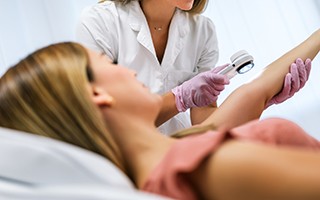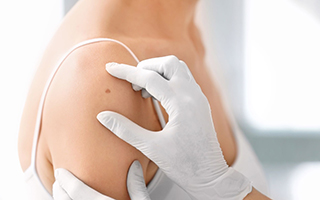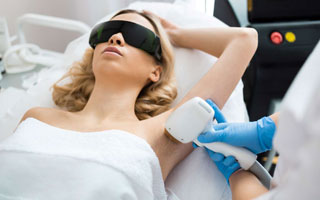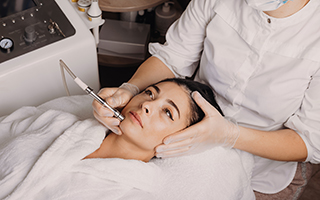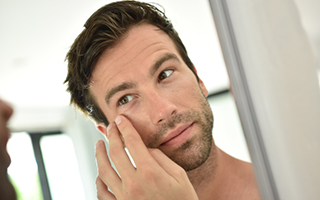Tinea Versicolor
Treatments for Yeast Infections of the Skin in Bryn Mawr, Newtown Square, Philadelphia, and the Main Line
- Home
- Medical Dermatology
- DERMATOLOGY CONDITIONS
- Tinea Versicolor
Patients who have noticed pinkish tan or white scaling patches on their body may have a condition caused by a yeast infection, known as tinea versicolor. The Bryn Mawr Skin & Cancer Institute team can help patients by correctly diagnosing and treating this dermatological condition with medications, as it is unlikely to disappear on its own if left untreated.
Dermatologists often work with patients who have a rash due to fungal and yeast infections, including ringworm, athlete’s foot, and tinea versicolor. It is most important to see a skin specialist to make the correct diagnosis and provide the appropriate treatment, as fungal and yeast infections are often misdiagnosed and treated incorrectly for months.
Bryn Mawr Skin & Cancer Institute provides comprehensive care for patients dealing with tinea versicolor. To schedule an appointment, Please BOOK ONLINE, call 610.525.5028 or Contact Us.
What Causes Tinea Versicolor?
Pityriasis versicolor, also known as tinea versicolor, is caused by Malassezia furfur, a form of yeast that grows naturally on the healthy skin of more than 90 percent of adults. This yeast usually doesn’t cause any issues until it overgrows.
Medical scientists do not fully understand why some patients experience this overgrowth of yeast and others do not. Risk factors for developing tinea versicolor include heat and humidity, genetic predisposition, a weakened immune system, malnutrition, and pregnancy.
What Are the Symptoms of Tinea Versicolor?
The most obvious signs of tinea versicolor are skin discolorations on areas such as the back, chest, neck, and upper arms, along with mild itching and scaling. These small patches of discolored skin may be several shades lighter or darker than the patient’s normal skin tone or appear brown, red, pink, or white (darker skin types).
Smaller patches can coalesce into larger patches. Tinea versicolor is a harmless condition that is not infectious and is generally asymptomatic other than causing mild itching. However, patients can experience emotional distress or self-consciousness due to the uneven appearance of their skin.
What Are the Risk Factors for Tinea Versicolor?
There are many factors that may increase a person’s risk of developing tinea versicolor, including:
- Living in a warm, humid climate
- Heavy perspiration that may be caused by hyperhidrosis
- Wearing tight-fitting clothing or athletic pads or applying occlusive creams that don’t let your skin breathe
- Being malnourished
- Having a weakened immune system
- Being a young adult or a teenager
- Being a man
- Having a family history of tinea versicolor
- Having certain types of cancer
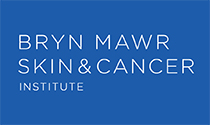
Meet Our Dermatologists &
Certified Physician Assistants
Our board-certified dermatologists & PA-Cs are dedicated to detecting and treating skin cancers. We treat the full spectrum of skin diseases. Our Mohs and Plastic Surgery practices are integrated, and offer patients the most advanced skin cancer treatment, delivering superior outcomes.
Treatment and Prevention Options for Tinea Versicolor
Although some patients find relief with over-the-counter anti-fungal/yeast creams, ointments, and shampoos, these are not effective for everyone. People with a persistent case can contact a dermatologist for prescription medications.
The Bryn Mawr Skin & Cancer Institute dermatologists will be able to accurately diagnose an infection by examining your skin or performing a skin scraping or biopsy. A blue light device, called a Wood’s lamp, is often used to identify this condition.
Despite successfully treating tinea versicolor with topical and oral medications, the lighter discolorations of the skin caused by azelaic acid, produced by the Malassezia, may remain for months.
Relapses typically occur in the warmer months of the year. If this occurs, dermatologists recommend starting preventative therapy with topical and oral medications as soon as the warm weather returns. Other steps that patients can take to ward off yeast infections include avoiding excessive heat and sweating, changing workout clothing right after working out, and washing the affected areas with Selsun Blue (selenium sulfide) shampoo several times per week.
Bryn Mawr Skin & Cancer Institute can assist patients with correct diagnosis and advanced treatments for yeast infections like tinea versicolor for patients in Bryn Mawr, Newtown Square, and the Philadelphia area. To schedule an appointment, Please BOOK ONLINE, call 610.525.5028, or Contact Us.




